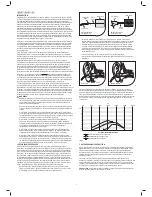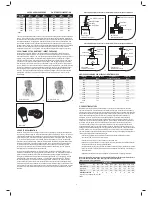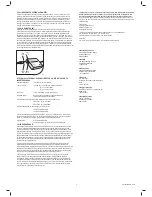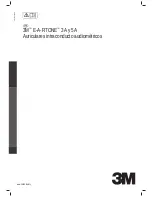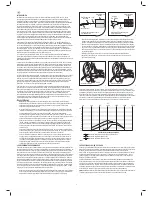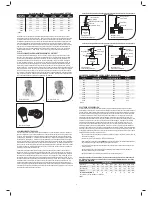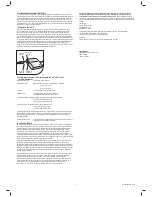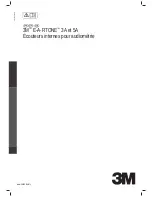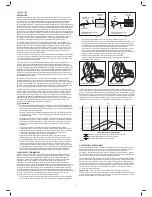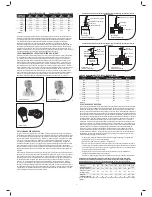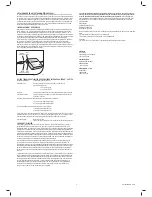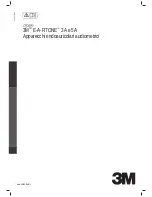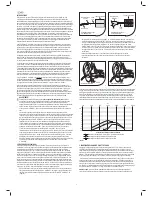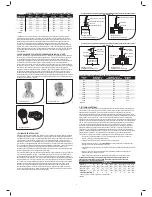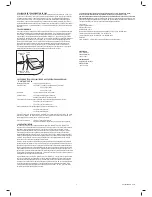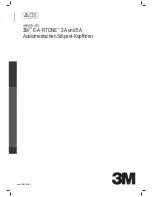
2
INTRODUCTION
Congratulations on the purchase of your new E-A-RTONE™ 3A or 5A Insert Earphones. Whether
you are performing comprehensive audiological diagnostic assessment, testing related to the fi tting
or evaluation of amplifi cation, audiological research, or hearing screening in an educational or
industrial setting, E-A-RTONE™ Insert Earphones provide many advantages that can enhance test
reliability and minimize or eliminate problems typically encountered with supra-aural earphones.
Because the test subject’s external canal is sealed with an E-A-RLINK™ foam eartip, reliable
threshold measurement can be accomplished in environments previously unsuitable for hearing
testing. The E-A-RTONE™ Insert Earphone’s direct coupling to the ear canal also provides greater
sound separation between ears across the test frequency range. That means more instances where
the need for masking is eliminated, or the level necessary for effective masking is lower. Average
testing time will decrease without sacrifi cing reliability. Your preferred method of clinical masking
does not need to be altered; simply substitute the greater inter-aural attenuation values cited in the
Obtained Inter-aural Attenuation table on page 2. of this booklet.
E-A-RLINK™ foam eartips are available in three sizes; a standard (3A) size that will comfortably fi t
most adult ear canals, a pediatric (3B) size for small ear canals, and a large (3C) size for very large
or surgically altered ear canals. Two additional sizes of eartips are available as “Infant Eartips” in
3.5mm and 4.0mm versions to accommodate very small ear canals. Disposable eartips eliminate
the need for periodic cleaning of a headband and earphone cushions, and they facilitate infection
control procedures.
The E-A-RTONE™ 3A and 5A Insert Earphones are available with two levels of impedance
(10
Ω
and 50
Ω
) to match the output of most commercially available audiometers. Your distributor
or a 3M Auditory Systems Customer Service Representative can help you determine which version
is appropriate for your equipment.
Unless your audiometer was purchased with an E-A-RTONE™ 3A or 5A Insert Earphone
pre-calibrated by the audiometric equipment manufacturer, the Reference Equivalent Threshold
Sound Pressure Level (RETSPL) values and procedure cited in the ANSI S3.6-2004 Standard
must be used to calibrate your equipment before initial use. Re-calibration should subsequently
be performed as specifi ed by the audiometer manufacturer; typically on an annual schedule.
Measured correction factors can be applied where it is necessary to alternate between an insert
earphone and a supra-aural earphone with audiometers that do not provide a dual calibration option.
E-A-RLINK™ foam eartips are designed for single-use and should be replaced with new eartips
for each test session performed. Re-use of these disposable eartips could result in inadvertent
intra- and inter-subject cross-infection via contact transmission, or “biological reactivity” problems
with the presence of residual chemicals when antimicrobial agents are used in an attempt to clean
and disinfect previously used foam eartips. Do not reuse E-A-RLINK™ foam eartips.
This instruction booklet provides information that will allow you to perform hearing testing with
your audiometer and E-A-RTONE™ Insert Earphones with the confi dence that test results will be
comparable to, or in certain instances more reliable than, measurements performed with supra-aural
earphones. Uncertainty regarding the use and calibration of E-A-RTONE™ Insert Earphones can
most often be resolved by reviewing this booklet and the American National Standard Specifi cation
for Audiometers (currently, ANSI S3.6-2004). For information regarding replacement items, please
contact your distributor or a 3M Auditory Systems Customer Service Representative.
WARNINGS
• Reliable test results can be obtained with this earphone only when the audiometric equipment
that it will be used with is calibrated to the device, before initial use, and periodically thereafter
as specifi ed by the audiometric equipment manufacturer, or in accordance with applicable
national or international standards.
• The use of accessories and replacement parts, other than those supplied by the manufacturer
of the E-A-RTONE™ Insert Earphone, or its authorized distributors, could result in invalid test
results.
• E-A-RTONE™ 3A Insert Earphone front tubes must be replaced periodically, typically on an
annual basis or whenever the tube(s) become brittle or perforated. Do not cut the sound tube to
forestall replacement. A change of 10mm in the length of the sound tube will result in a change
of the frequency response by as much as 0.5 dB at some frequencies.
• E-A-RTONE™ 3A and 5A Insert Earphones are available in two different impedance
versions (10 ohm and 50 ohm) to accommodate most commercially available audiometric
equipment. Before initial calibration and use, confi rm that the output impedance requirements
of the audiometric equipment and the E-A-RTONE™ Insert Earphone impedance
(as identifi ed in the Serial number) are the same.
• E-A-RTONE™ 3A and 5A Insert Earphone replacement cables are not interchangeable
between the two models, and in the case of the E-A-RTONE™ 5A Insert Earphone, cable
replacement must be both model and impedance specifi c (5A 10 ohm or 5A 50 ohm).
• E-A-RLINK™ foam eartips are designed for single use and should be replaced with new
eartips for each test performed. Re-use of these eartips could result in inadvertent intra- and
inter- subject cross-infection via contact transmission, or “biological reactivity” problems with
the presence of residual chemicals when antimicrobial agents are used in an attempt to clean
and disinfect previously used foam eartips. Do not reuse E-A-RLINK™ foam eartips.
1. PRELIMINARY PROCEDURES
Examine each ear canal for obstruction(s), and visually determine the appropriate size of
E-A-RLINK™ foam eartip needed to fi t the test subject’s ear canals. An airtight seal is necessary,
and some test subjects may require different size eartips for the right and left ear. The standard
size E-A-RLINK™ 3A eartip fi ts most adult ear canals, and the smaller diameter, beige color foam
E-A-RLINK™ 3B eartips are available if the standard size eartip is too large for full insertion into
small ear canals. Larger diameter E-A-RLINK 3C eartips are also available to obtain a good seal
for test subjects with wide or surgically altered ear canals. A good seal and the proper insertion
depth will provide the greatest ambient and inter-aural attenuation. Deep insertion may be diffi cult
to achieve in extremely small ear canals, even with the small 3B size eartip. In these instances,
a shallow E-A-RLINK™ 3B eartip placement, or the use of the smaller 3.5 mm or 4.0 mm “Infant
Eartips” should be employed. Once the appropriate eartip size has been selected;
• Secure the section of black tubing extending from the eartip onto the plastic sound tube
nipple of the E-A-RTONE™ 3A Insert Earphone’s front tube (Figure 1.) or, directly onto the
E-A-RTONE™ 5A Insert Earphone’s stainless steel case nipple (Figure 2.).
• For the E-A-RTONE 3A Insert Earphone™, slowly roll the E-A-RLINK™ eartip into the
smallest diameter possible, and while holding the black tubing where it connects with the tube
nipple, insert the eartip deeply into the ear canal. The procedure is essentially the same for
the E-A-RTONE™ 5A Insert Earphone except that once the eartip is compressed, instead
of holding the black tubing, grasping the transducer case between the thumb and forefi nger
will facilitate the correct insertion. The correct (“Full”) insertion depth is obtained when the
outward-facing edge of the E-A-RLINK™ eartip is 2-3 mm inside the entrance of the ear canal
as illustrated in Figure 3.
• Hold the E-A-RLINK™ eartip in place in the ear canal until it has expanded.
• After the test is completed, remove the eartips and replace them with a new pair for the next
test subject.
-10
0
10
20
30
40
50
60
70
80
90
100
110
125 250 500 1000 2000 4000 8000
Hz
dB
Obtained Interaural Attenuation
Full E-A-RLINK insertion in both ears
Shallow insertion in dead ear only
Shallow insertion in both ears
Table 1.
Full insertion depth, as described above, and illustrated in Figure 3., is necessary to achieve
maximum ambient noise attenuation and inter-aural attenuation. Shallow insertion, as illustrated
in Figure 4. may be the only option for certain ear canals, but more commonly refl ects incomplete
compression of the eartip before insertion. Table 1. below illustrates inter-aural attenuation as a
function of the eartip insertion depth. The described inter-aural attenuation is obtained for each ear
in which the E-A-RLINK™ eartip is fully inserted, regardless of whether it is the “sending” ear or
“receiving” ear.
2. BACKGROUND NOISE REDUCTION
A major benefi t of the E-A-RTONE™ Insert Earphone is the reduction of background noise that
might otherwise mask air or bone conduction test signals and infl uence threshold determinations.
Ambient noise attenuation with an E-A-RTONE™ Insert Earphone typically exceeds 30 dB in
the frequency region of 125-8000Hz. Audiometric air conduction threshold testing down to 0 dB
Hearing Level (HL) can be reliably performed in the presence of a background noise level not
exceeding 45 dB(A).
The current ANSI Standard “Maximum Permissible Ambient Noise Levels“ (MPANLs) For
Audiometric Test Rooms” (ANSI S3.1-1999 Table 1 and Table 2 ) includes octave band and one-third
octave band permissible noise levels for both supra-aural and E-A-RTONE™ Insert Earphones.
The ANSI octave band MPANLs are presented here in Table 2. below for standard earphones and
for E-A-RTONE™ Insert Earphones with fully inserted E-A-RLINK™ eartips.
ANSI S3.1-1999 - Ears covered: octave band MPANLs using a supra-aural or insert earphone for
three test frequency ranges re: 20
μ
Pa to nearest 0.5 dB.
2
Eartip connection for
E-A-RTONE™3A
1
Sound tube
nipple
Foam eartip
Sound tube
Black
tubing
Eartip connection for
E-A-RTONE™5A
E-A-RTONE
Case
Foam eartip
Black
tubing
Full insertion
Shallow insertion
2-3 mm
3
4
GZXO$
Summary of Contents for E-A-RTONE 3A
Page 1: ...34 8708 1478 6 www 3M EU Safety 3M E A RTONE 3A and 5A Audiometric Insert Earphones GZXO ...
Page 9: ...34 8708 1478 6 www 3M EU Safety 3M E A RTONE 3A et 5A Écouteurs internes pour audiométrie FzB ...
Page 17: ...34 8708 1478 6 www 3M EU Safety 3M E A RTONE 3A und 5A Audiometrischen Stöpsel Kopfhörer Dza ...


